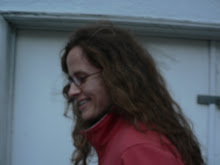The 400 Blows (Francois Truffaut)
Funny Games, 1997 version (Michael Henake)
High Fidelity (Stephen Frears)
Jules and Jim (Francois Truffaut)
Some Like It Hot (Billy Wilder)
Children of Men (Alfonso Cuaron)
Ferris Beuller's Day Off (John Hughes)
The Conformist (Bernardo Bertolucci)
The Blair Witch Project (Daniel Myrick & Eduardo Sanchez)
Buffy the Vampire Slayer: "Once More With Feeling" (Joss Whedon)
Twin Peaks, a few scenes featuring Bob (David Lynch)
smatterings of commercials, news programs
Course Objectives:
What does it mean when a fictitious character looks at a real camera. Is it the same thing as looking at you. Who are you and why are you watching these films. Do you feel as though you're part of the conversation, part of the creation, part of the story. Are you implicated and by what. What's wrong with you and what's wrong with the world. Are you a thoughtless voyeur when you don't acknowledge the camera. How many times does one director get to use this technique. Is it funny for an actor to look into the camera. Why would a filmmaker find it necessary to address the action. Where is the beginning and end of fiction, of fantasy. Who controls the story. Is this technique stronger when it ends a film. Why do people in commercials talk like that; don't they know that no one speaks to me in that manner. Like a baby. Like an idiot. Why do newscasters speak with their eyebrows. Does blood splattering on the camera count as acknowledgement. Name a film to use as contrast.




5 comments:
As a contrast: films where we see the camera apparatus itself--for instance, in a mirror like in Carlos Saura's Tango, or one camera shooting another, like in David Lynch's Inland Empire. Or Hollywood movies in general where we meet both character and "actor" - like Altman's The Player or The French Lieutenant's Woman... One could also look at the impact of gaffes like when boom mics drop into frame. I promise I didn't buy a ticket for this but when I was waiting at a theater one time and wandered into the movie where the Olsen twins go to Columbia, there was a boom mic in nearly every scene, which may as well be talking to the audience. I bet someone could do a great final paper on blooper reels in general. Characters bursting out laughing, pranking each other, etc.
Another contrast: characters speaking to themselves in a mirror and therefore to us at the same time (i.e. Taxi Driver) or characters appearing on television ostensibly speaking into the television camera for an imaginary audience in the world of the film but really speaking directly to us the viewer of the film (too many to list, from Network to LA Story to Broadcast News to Anchorman and countless others). Both are ways for the characters to speak directly to the audience while appearing to speak to someone inside the film.
Several of Woody Allen's films do this also.
I hate when a movie has a body-of-water scene and there are droplets on the lens.
Or what about when the camera is placed at curb level on a rain-soaked street and a car swerves around a bend so that the tires splash against the lens . . . ugh.
Beckett's "Film" (starring Buster Keaton) http://www.ubuweb.com/film/beckett_film.html
Maybe illustrates an extreme example of what you are talking about? All the characters in the film address the camera with expressions of horror. One person stares at the camera and promptly dies. Classic.
Post a Comment